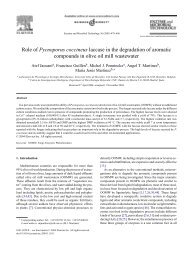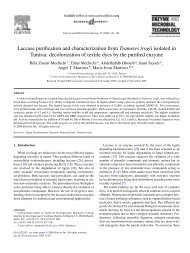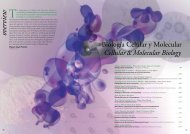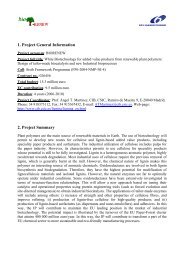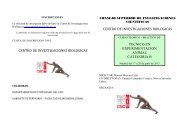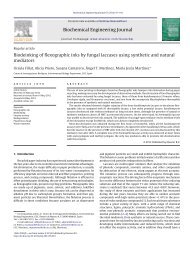03 Medicina Celular y Molecular.pdf 5474KB May - Centro de ...
03 Medicina Celular y Molecular.pdf 5474KB May - Centro de ...
03 Medicina Celular y Molecular.pdf 5474KB May - Centro de ...
Create successful ePaper yourself
Turn your PDF publications into a flip-book with our unique Google optimized e-Paper software.
<strong>Medicina</strong> <strong>Celular</strong> y <strong>Molecular</strong> | Cellular and <strong>Molecular</strong> Medicine<br />
92<br />
Carmelo Bernabeu Quirante<br />
Profesor <strong>de</strong> Investigación | bernabeu.c@cib.csic.es<br />
Receptores <strong>de</strong> TGF-β en Células Endoteliales<br />
Nuestro laboratorio estudia la expresión<br />
génica, estructura y función <strong>de</strong> los<br />
receptores <strong>de</strong> TGF-β endoglina y<br />
ALK1, tanto en la fisiología normal como en<br />
el contexto <strong>de</strong> la patología humana, y en<br />
especial en HHT. Mutaciones en los genes <strong>de</strong><br />
endoglina o ALK1 dan lugar a HHT1 y HHT2,<br />
respectivamente, las cuales están asociadas<br />
con frecuentes epistaxis, hemorragias<br />
gastrointestinales, telangiectasias cutáneas, y<br />
malformaciones arteriovenosas en pulmón,<br />
hígado y cerebro (OMIM #187300). Los estudios<br />
<strong>de</strong> expresión <strong>de</strong> las proteínas mutantes han<br />
establecido que la haploinsuficiencia explica<br />
las manifestaciones clínicas <strong>de</strong> la HHT, ya que<br />
la mayoría <strong>de</strong> las proteínas mutantes o bien<br />
no se expresan en la superficie celular, o no<br />
son funcionales. Entre los objetivos científicos<br />
<strong>de</strong>l grupo se incluyen: i) Llevar a cabo el<br />
diagnóstico molecular <strong>de</strong> HHT mediante<br />
secuenciación <strong>de</strong> los exones <strong>de</strong> endoglina y<br />
ALK1 en la población <strong>de</strong> pacientes españoles;<br />
PhD, 1977.<br />
Universidad Autónoma <strong>de</strong> Madrid.<br />
Postdoctoral Scholar, 1980-1981.<br />
<strong>Molecular</strong> Biology Institute, University of California,<br />
Los Angeles, USA.<br />
Research Fellow, 1982-1983.<br />
Dana-Farber Cancer Institute, Harvard Medical<br />
School, Boston, Massachusetts, USA.<br />
Científico Titular, 1985,<br />
Jefe <strong>de</strong> grupo, 1988,<br />
Investigador Científico, 1987,<br />
Profesor <strong>de</strong> Investigación, 20<strong>03</strong>.<br />
CIB, CSIC.<br />
Endoglina y ALK1 son miembros <strong>de</strong>l complejo receptor <strong>de</strong> TGF-β en células<br />
endoteliales con implicaciones en la fisiopatología vascular. Mutaciones<br />
en los genes <strong>de</strong> endoglina o ALK1 (ACVRL1) son responsables <strong>de</strong> la<br />
Telangiectasia Hemorrágica Hereditaria (HHT), una enfermedad vascular<br />
autosómica dominante. Endoglina y ALK1 regulan la angiogénesis y<br />
homeostasis vascular, y una forma soluble <strong>de</strong> endoglina tiene un papel<br />
patogénico en preeclampsia. A<strong>de</strong>más, endoglina es un marcador <strong>de</strong> la<br />
neoangiogénesis tumoral y es un supresor <strong>de</strong> tumores epiteliales.<br />
Estructura tridimensional <strong>de</strong> endoglina y ALK1<br />
y sus mutaciones en HHT. Las mutaciones<br />
missense y nonsense <strong>de</strong>scritas para la parte<br />
extracelular <strong>de</strong> endoglina y la parte intracelular<br />
<strong>de</strong> ALK1 se muestran como esferas ver<strong>de</strong>s<br />
y segmentos rojos, respectivamente. El<br />
volumen <strong>de</strong> las esferas ver<strong>de</strong>s está relacionado<br />
exclusivamente con el tamaño <strong>de</strong>l residuo<br />
mutado en la ca<strong>de</strong>na. El bucle L45, el dominio<br />
GS y el sitio <strong>de</strong> union <strong>de</strong> caveolina-1 en ALK1<br />
tambien se indican. Adaptado <strong>de</strong> Bernabeu et<br />
al. (2010) J. Applied. Biomed. 8: 169-177.<br />
Endoglin and ALK1 three dimensional structure<br />
and HHT mutations. The missense and nonsense<br />
mutations <strong>de</strong>scribed for the extracellular part<br />
of endoglin and the intracellular part of ALK1<br />
are shown as green spheres and red segments,<br />
respectively. The volume of the green spheres<br />
is exclusively related to the size of the mutated<br />
residue si<strong>de</strong> chain. The L45 loop, the GS domain<br />
and the caveolin-1 binding motif of ALK1 are also<br />
indicated. Adapted from Bernabeu et al. (2010) J.<br />
Applied. Biomed. 8: 169-177.<br />
ii) Buscar nuevos biomarcadores en HHT;<br />
iii) Analizar los mecanismos <strong>de</strong> regulación<br />
transcripcional <strong>de</strong> los genes <strong>de</strong> endoglina y<br />
ALK1; iv) Obtener cultivos primarios <strong>de</strong> células<br />
endoteliales y monocitos activados a partir<br />
<strong>de</strong> sangre periférica <strong>de</strong> pacientes HHT para<br />
estudios <strong>de</strong> expresión genica, bioquímicos, <strong>de</strong><br />
señalización celular y para ensayos <strong>de</strong> terapias<br />
célulo-génicas en ratones; v) Analizar la función<br />
y los patrones <strong>de</strong> expresión génica <strong>de</strong> celulas<br />
transfectantes que sobreexpresan las dos<br />
isoformas <strong>de</strong> endoglina; vi) generar ratones<br />
transgénicos que sobreexpresen endoglina<br />
soluble y analizar el impacto en la hipertensión<br />
arterial; vii) generar ratones KO condicionales<br />
<strong>de</strong> endoglina en el linaje mieloi<strong>de</strong> para analizar<br />
el impacto <strong>de</strong> HHT en el sistema inmune; viii)<br />
Buscar medicamentos huérfanos con posible<br />
aplicación en HHT y estudiar su mecanismo<br />
<strong>de</strong> acción; y ix) Estudiar la estructura<br />
tridimensional <strong>de</strong> los complejos <strong>de</strong> endoglina,<br />
ALK1 y miembros <strong>de</strong> la familia <strong>de</strong>l TGF-β.<br />
Luisa-maría Botella Cubells<br />
Investigadora Científica | cibluisa@cib.csic.es<br />
PhD, 1985.<br />
Universidad <strong>de</strong> Valencia.<br />
Visiting Scientist, post-doc, 1986-1988.<br />
Genetiska Institutionen, Wallenberg Laboratory,<br />
Universidad <strong>de</strong> Lund, Suecia.<br />
Científica Titular, 1989,<br />
Investigadora Científica, 2007.<br />
CIB, CSIC.<br />
Publicaciones Seleccionadas<br />
Selected Publications<br />
Bernabeu C, Lopez-Novoa JM, Quintanilla M.<br />
(2009). The emerging role of TGF-beta superfamily<br />
coreceptors in cancer. Biochim. Biophys. Acta.<br />
1792, 954-973.<br />
Botella LM, Sanz-Rodriguez F, Komi Y, Fernan<strong>de</strong>z-L<br />
A, Varela E, Garrido-Martin EM, Narla G, Friedman SL,<br />
Kojima S. (2009). TGF-beta regulates the expression<br />
of transcription factor KLF6 and its splice variants<br />
and promotes co-operative transactivation of<br />
common target genes through a Smad3-Sp1-KLF6<br />
interaction. Biochem J. 419, 485-495.<br />
Cristobal I, Blanco FJ, Garcia-Orti L, Marcotegui<br />
N, Vicente C, Rifon J, Novo FJ, Bandres E,<br />
Calasanz MJ, Bernabeu C, O<strong>de</strong>ro MD. (2010).<br />
SETBP1 overexpression is a novel leukemogenic<br />
mechanism that predicts adverse outcome in<br />
el<strong>de</strong>rly patients with acute myeloid leukemia.<br />
Blood. 115, 615-625.<br />
Albiñana V, Bernabeu-Herrero ME, Zarrabeitia R,<br />
Bernabeu C, Botella LM. (2010). Estrogen therapy<br />
for Hereditary Haemorrhagic Telangiectasia<br />
(HHT): Effects of Raloxifene, on Endoglin and<br />
ALK1 expression in endothelial cells. Thromb.<br />
Haemost. 1<strong>03</strong>, 525-534.<br />
Ojeda-Fernan<strong>de</strong>z L, Barrios L, Rodriguez-Barbero<br />
A, Recio-Poveda L, Bernabeu C, Botella LM. (2010).<br />
Reduced plasma levels of Ang-2 and sEng as novel<br />
biomarkers in Hereditary Hemorrhagic Telangiectasia<br />
(HHT). Clin. Chim. Acta. 411, 494-499.<br />
Garrido-Martin EM, Blanco FJ, Fernan<strong>de</strong>z-L A,<br />
Langa C, Vary CP, Lee UE, Friedman SL, Botella LM,<br />
Bernabeu C. (2010). Characterization of the human<br />
Activin-A receptor type II-like kinase 1 (ACVRL1)<br />
promoter and its regulation by Sp1. BMC Mol.<br />
Biol. 11(1): 51 (22 pags).<br />
Bernabeu C, Blanco FJ, Langa C, Garrido-Martin<br />
EM, Botella LM. (2010). Involvement of the TGFbeta<br />
superfamily signalling pathway in hereditary<br />
haemorrhagic telangiectasia. J. Applied Biomed.<br />
8, 169-177.<br />
Lopez-Novoa JM, Bernabeu C. (2010).<br />
The physiological role of endoglin in the<br />
cardiovascular system. Am. J. Physiol. Heart Circ.<br />
Physiol. 299, H959-974.<br />
Santibanez JF, Perez-Gomez E, Fernan<strong>de</strong>z-L A,<br />
Garrido-Martin, EM, Carnero A, Malumbres M,<br />
Vary CPH, Quintanilla M, Bernabeu C. (2010). The<br />
TGF-beta co-receptor endoglin modulates the<br />
expression and transforming potential of H-Ras.<br />
Carcinogenesis. 31, 2145-2154.<br />
Perez-Gomez E, Del Castillo G, Santibañez JF, Lopez-<br />
Novoa JM, Bernabeu C, Quintanilla M. (2010). The<br />
role of the TGF-beta coreceptor endoglin in cancer.<br />
ScientificWorldJournal. 10, 2367-2384.<br />
Otros miembros | Other lab members:<br />
Francisco Javier Blanco Lopez<br />
Elisa Rossi<br />
Eva María Garrido Martin<br />
Ana Cristina Valbuena Díaz<br />
María Luisa Ojeda Fernán<strong>de</strong>z<br />
Virginia Albiñana Díaz<br />
Mikel Aristorena San Adrian<br />
Carmen Langa Poza<br />
Lucia Recio Poveda<br />
www.cib.csic.es/es/grupo.php?idgrupo=22<br />
TGF-β Receptors in<br />
Endothelial Cells<br />
Endoglin and ALK1 are components of the TGF-β<br />
receptor complex in endothelial cells that are<br />
involved in vascular physiopathology. Mutations in<br />
endoglin or ALK1 (ACVRL1) genes give rise to the<br />
Hereditary Hemorrhagic Telangiectasia (HHT), a<br />
dominant autosomic vascular dysplasia. Endoglin<br />
and ALK1 regulate angiogenesis and vascular<br />
homeostasis, and a soluble form of endoglin has<br />
a pathogenic role in preeclampsia. In addition,<br />
endoglin is a marker of tumor neoangiogenesis and<br />
is a suppressor of epithelial tumors.<br />
Our laboratory studies the gene expression, structure and<br />
function of the TGF-β receptors endoglin and ALK1, in<br />
normal physiology and in the context f human pathology,<br />
with special emphasis in HHT. Mutations in endoglin or ALK1 genes<br />
give raise to HHT1 or HHT2, respectively, which are associated with<br />
Mo<strong>de</strong>lo hipotético <strong>de</strong>l papel <strong>de</strong> endoglina en la apoptosis <strong>de</strong> la célula<br />
endotelial y su relevancia en las lesiones vasculares <strong>de</strong> HHT. En presencia <strong>de</strong><br />
<strong>de</strong>terminados estímulos, tales como TGF-β e hipoxia, las células endoteliales<br />
sufren un proceso <strong>de</strong> apoptosis que es prevenido por la expresión<br />
inducida <strong>de</strong> endoglina en los individuos sanos. En los pacientes HHT, la<br />
haploinsuficiencia <strong>de</strong> endoglina pue<strong>de</strong> conducer a una apoptosis masiva<br />
frequent epistaxis, gastrointestinal<br />
hemorrhages, cutaneous telangiectasis<br />
and arteriovenous malformations in<br />
lung, liver and brain (OMIM #187300).<br />
Expression studies of mutant proteins<br />
have <strong>de</strong>monstrated that the mechanism of<br />
haploinsufficiency accounts for the clinical<br />
manifestations of HHT because most of the<br />
mutant proteins are either not expressed or are<br />
non functional. Among the scientific aims of our<br />
group are: i) To carry out the molecular diagnosis of<br />
HHT by sequencing endoglin and ALK1 exons from the<br />
Spanish HHT patients; ii) To search for new biomarkers in<br />
HHT; iii) Analyze the mechanisms of transcriptional regulation<br />
of endoglin and ALK1 genes; iv) To generate primary cultures<br />
of endothelial cells and activated monocytes <strong>de</strong>rived from<br />
blood samples of HHT patients for studies on gene expression,<br />
biochemistry, cellular signalling and assays of cellular-genetic<br />
therapies in mice; v) To analyze the function and gene expression<br />
patterns of transfectant cells overexpressing the two endoglin<br />
isoforms; vi) To generate transgenic mice overexpressing soluble<br />
endoglin and analyze the impact on arterial hypertension; vii) To<br />
generate a conditional Endoglin KO mice in the myeloid lineage to<br />
analyze the impact of HHT on the immune system; viii) To search<br />
for orphan drugs with potential application in HHT and study of<br />
their mechanisms of action; ix) To study the three dimensional<br />
structure of endoglin, ALK1 and members of the TGF-β family.<br />
apoptosis en las células endoteliales, don<strong>de</strong> la función <strong>de</strong> endoglina es<br />
requerida para la supervivencia, conduciendo a una regresión <strong>de</strong> los capilares.<br />
Se muestra una sección transversal <strong>de</strong> un vaso individual con celulas<br />
endoteliales en rojo, pericitos en azul y células endoteliales apoptóticas en<br />
rosa. Adaptado <strong>de</strong> Lopez-Novoa & Bernabeu (2010) Am. J. Physiol. Heart Circ.<br />
Physiol. 299: H959-974.<br />
Hypothetical mo<strong>de</strong>l for the role of<br />
endoglin in EC apoptosis, and its relevance<br />
in HHT vascular lesions. Un<strong>de</strong>r certain<br />
stimuli, such as TGF-β and hypoxia, ECs<br />
un<strong>de</strong>rgo apoptosis that is prevented<br />
by the induced expression of endoglin<br />
in healthy subjects. In HHT patients,<br />
endoglin haploinsufficiency may lead to a<br />
massive apoptosis in ECs where endoglin<br />
function is required for survival leading<br />
to capillary regression. A cross-section of<br />
an individual vessel is <strong>de</strong>picted with ECs<br />
in red, pericytes in blue and apoptotic<br />
ECs in pink. Adapted from Lopez-Novoa &<br />
Bernabeu (2010) Am. J. Physiol. Heart Circ.<br />
Physiol. 299, H959-974.<br />
93




